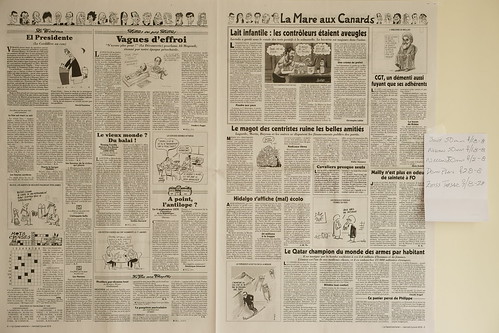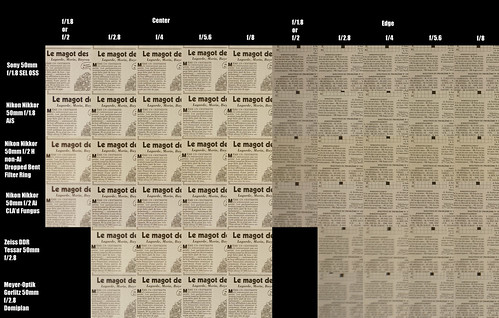Occasionally I receive confirmation that I'm completely nuts.
Last year I decided to try and find the best lenses I could for less than 50 Euro. I scored four or five lenses for that price or less. Then one day things changed, again. I won an auction for a mint Super-Takumar 200mm f/4 for 11 Euro and it felt like the bottom had fallen out of my expectations for the old used lens market.
Confirmation of my lack of mental stability more recently arrived in the form of a box originating from Germany. It held six lenses that I'd won in an auction off eBay point fr. To be a bit more precise, it was a box filled with _cheap_ lenses. The cost averaged across the entire purchase was 7 Euro per objectif.
Sorting through things I found four lenses of particular interest. There was a Zeiss Jena DDR Tessar 50mm f/2.8, a Meyer-Optik Gorlitz 50mm f/2.8 Domiplan, a Schneider-Kruzenach 135mm f/3.5, and a Nikon Nikkor 50mm f/2 Ai. The other two lenses will be sold for cheap (the mounts are nothing I would ever use).
What encouraged me to bid on the auction were the two "bubble bokeh" lenses (not that I'm particularly "into" "bubble bokeh"), the Jena DDR Tessar and the Domiplan. The Angry Photographer had good things to say about the lenses, so I decided to try my luck.
The Tessar lens design is well known and very well proven with well over a hundred years of implementation by a wide variety of manufacturers. It consists of four lens elements in three groups. The German made glass has the best reputation and prices are at times rather robust.
The Meyer-Optik Gorlitz Domiplan is a simple three element three group design. It was made to be inexpensive and easily manufactured. I see these at the photo swaps here in Europe. Prices are variable and no one seems to buy them. No one seems to like them.
Setup
Last year I decided to try and find the best lenses I could for less than 50 Euro. I scored four or five lenses for that price or less. Then one day things changed, again. I won an auction for a mint Super-Takumar 200mm f/4 for 11 Euro and it felt like the bottom had fallen out of my expectations for the old used lens market.
Confirmation of my lack of mental stability more recently arrived in the form of a box originating from Germany. It held six lenses that I'd won in an auction off eBay point fr. To be a bit more precise, it was a box filled with _cheap_ lenses. The cost averaged across the entire purchase was 7 Euro per objectif.
Sorting through things I found four lenses of particular interest. There was a Zeiss Jena DDR Tessar 50mm f/2.8, a Meyer-Optik Gorlitz 50mm f/2.8 Domiplan, a Schneider-Kruzenach 135mm f/3.5, and a Nikon Nikkor 50mm f/2 Ai. The other two lenses will be sold for cheap (the mounts are nothing I would ever use).
What encouraged me to bid on the auction were the two "bubble bokeh" lenses (not that I'm particularly "into" "bubble bokeh"), the Jena DDR Tessar and the Domiplan. The Angry Photographer had good things to say about the lenses, so I decided to try my luck.
The Tessar lens design is well known and very well proven with well over a hundred years of implementation by a wide variety of manufacturers. It consists of four lens elements in three groups. The German made glass has the best reputation and prices are at times rather robust.
The Meyer-Optik Gorlitz Domiplan is a simple three element three group design. It was made to be inexpensive and easily manufactured. I see these at the photo swaps here in Europe. Prices are variable and no one seems to buy them. No one seems to like them.
Setup
- Sony A6000, 100ISO, AWR converted in Sony's software
- Big Beefy Manfrotto tripod
- Lenses -
- Sony 50mm f/1.8 SEL OSS (as the "control" lens)
- Nikon Nikkor 50mm f/1.8 AiS
- Nikon Nikkor 50mm f/2 H non-Ai
- Nikon Nikkor 50mm f/2 Ai
- Zeiss Jena DDR Tessar 50mm f/2.8 (M42 mount)
- Meyer-Optik Gorlitz 50mm f/2.8 Domiplan (M42 mount)
The adapted lenses were shot using "straight through" adapters. None of them were mounted on a focal reducer. So what we will observe here is full frame lens performance on APS-C sized/cropped sensors. This means the very outer limits of the field of view will not be compared at all. If something already performs poorly at the outer edges of the APS-C frame, it will very likely be pretty horrible at the far edges of the full frame 35mm format.
Here is the scene -
Here is the scene -
Comparison Results
[If you click on the image it'll take you to the Flickr hosting site. Once there, look at the file at full resolution. In many cases the differences between lenses is small and likely can't be seen until you take a squint at the comparison at 100 percent.]
[If you click on the image it'll take you to the Flickr hosting site. Once there, look at the file at full resolution. In many cases the differences between lenses is small and likely can't be seen until you take a squint at the comparison at 100 percent.]
Observations
The Sony 50mm f/1.8 SEL OSS acted as the "control" lens. It's performance is brilliant from wide open clear across the field. This lens feels resolution limited by the sensor, it's that sharp. It's light and easy to carry on Sony APS-C mirrorless cameras. When I want AF, it's my "go to" lens in this focal length.
The Nikon Nikkor 50mm f/1.8 AiS continues to impress me. While it's a little soft wide open due to spherical aberrations, starting one stop down it matches the Sony. The lens is small and light. Being a pancake lens it looks like the more common E-series Nikon of this focal length and aperture. If I could carry just one lens, this might be it (but only when coupled with a Lens Turbo II focal reducer which gives a full frame 35mm field of view on the APS-C format).
Another lens that I already owned is the Nikon Nikkor 50mm f/2 H non-Ai. In the Box of Toys, however, there was a Nikon Nikkor 50mm f/2 Ai. The Angry Photographer on YouTube loves this lens. So, I was interested to see how the two lenses of the same design but very different years of manufacturing might compare. What I found is that the Ai version is slightly sharper (though one has to look very carefully) and the scene color matches other newer Ai and AiS Nikkors. The old "H" version gives a warmer rendition (which is easily accounted for in processing). For 7 Euros I think I'll be keeping the Ai (along with all the other lenses I can't seem to relieve myself of).
Next comes the Zeiss Jena DDR Tessar 50mm f/2.8. For years I've heard about how wonderful Zeiss lenses are. I've owned a number of these Tessar 50mm lenses of various vintages and, honestly, I've been underwhelmed. This little pancake lens is no different. It performs identically to every single 50mm Tessar I've ever looked at. It's strange how consistent the lenses are between manufacturing sites and vintages. That is to say, they are all soft wide open and never seem to "clean up" (sharpen up, if you like) as the lenses are stopped down. I would've thought that by f/5.6 that lenses would match the Sonnar or Double Gauss design lenses, but they never ever do. I'm not sure where the "magic" is supposed to be in these because I've never been able to find it. I think the famous photographer David Duncan Douglas had this all sorted out over sixty years ago when he was in Japan and discovered Nikkor optics.
Lastly comes the very lowly three element airspace design Meyer-Optik Gorlitz 50mm f/2.8 Domiplan. The lens is very light, very simple, and feels a little feeble. Yet there's a little surprise. Yes, it's well know for it's out of focus rendition. It certainly has that to recommend itself. In terms of resolution the edges of the APS-C format frame shows an incredible drop-off. I can't imagine what the edges of full-frame 35mm look like. It must be pure mush However, the center of the field is sharp. It's as sharp as anything of the era. There's the surprise. In fact, it's sharper than the Zeiss Jena DDR. Because of this I find the Domiplan an amusing little curiosity. It's like coming across a "cheeky little 2 Euro wine" from Bordeaux.
The Nikon Nikkor 50mm f/1.8 AiS continues to impress me. While it's a little soft wide open due to spherical aberrations, starting one stop down it matches the Sony. The lens is small and light. Being a pancake lens it looks like the more common E-series Nikon of this focal length and aperture. If I could carry just one lens, this might be it (but only when coupled with a Lens Turbo II focal reducer which gives a full frame 35mm field of view on the APS-C format).
Another lens that I already owned is the Nikon Nikkor 50mm f/2 H non-Ai. In the Box of Toys, however, there was a Nikon Nikkor 50mm f/2 Ai. The Angry Photographer on YouTube loves this lens. So, I was interested to see how the two lenses of the same design but very different years of manufacturing might compare. What I found is that the Ai version is slightly sharper (though one has to look very carefully) and the scene color matches other newer Ai and AiS Nikkors. The old "H" version gives a warmer rendition (which is easily accounted for in processing). For 7 Euros I think I'll be keeping the Ai (along with all the other lenses I can't seem to relieve myself of).
Next comes the Zeiss Jena DDR Tessar 50mm f/2.8. For years I've heard about how wonderful Zeiss lenses are. I've owned a number of these Tessar 50mm lenses of various vintages and, honestly, I've been underwhelmed. This little pancake lens is no different. It performs identically to every single 50mm Tessar I've ever looked at. It's strange how consistent the lenses are between manufacturing sites and vintages. That is to say, they are all soft wide open and never seem to "clean up" (sharpen up, if you like) as the lenses are stopped down. I would've thought that by f/5.6 that lenses would match the Sonnar or Double Gauss design lenses, but they never ever do. I'm not sure where the "magic" is supposed to be in these because I've never been able to find it. I think the famous photographer David Duncan Douglas had this all sorted out over sixty years ago when he was in Japan and discovered Nikkor optics.
Lastly comes the very lowly three element airspace design Meyer-Optik Gorlitz 50mm f/2.8 Domiplan. The lens is very light, very simple, and feels a little feeble. Yet there's a little surprise. Yes, it's well know for it's out of focus rendition. It certainly has that to recommend itself. In terms of resolution the edges of the APS-C format frame shows an incredible drop-off. I can't imagine what the edges of full-frame 35mm look like. It must be pure mush However, the center of the field is sharp. It's as sharp as anything of the era. There's the surprise. In fact, it's sharper than the Zeiss Jena DDR. Because of this I find the Domiplan an amusing little curiosity. It's like coming across a "cheeky little 2 Euro wine" from Bordeaux.


No comments:
Post a Comment